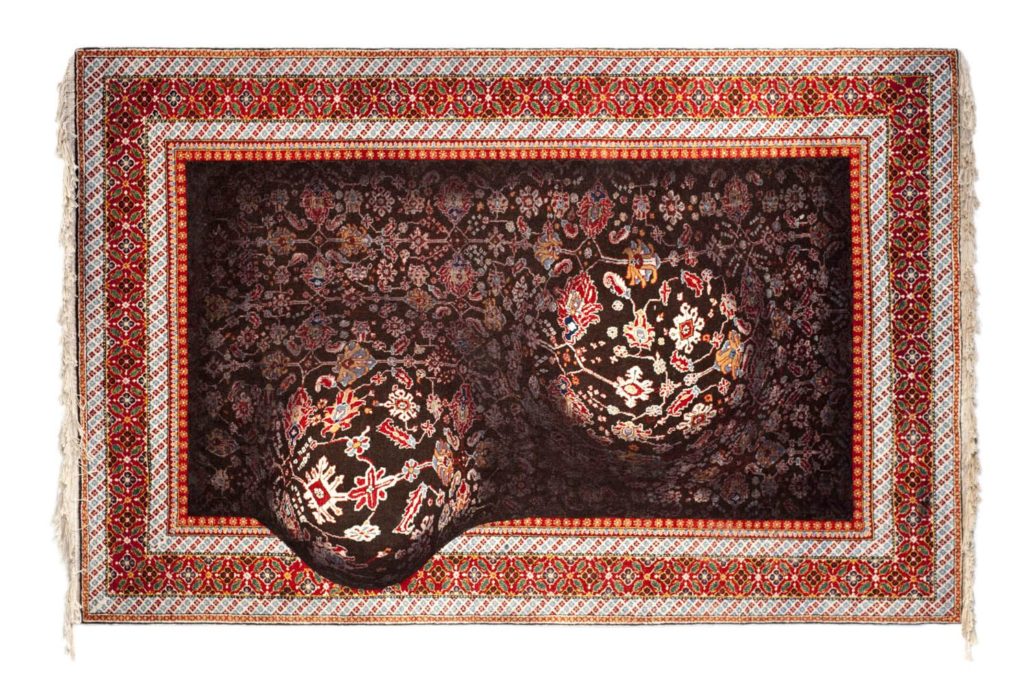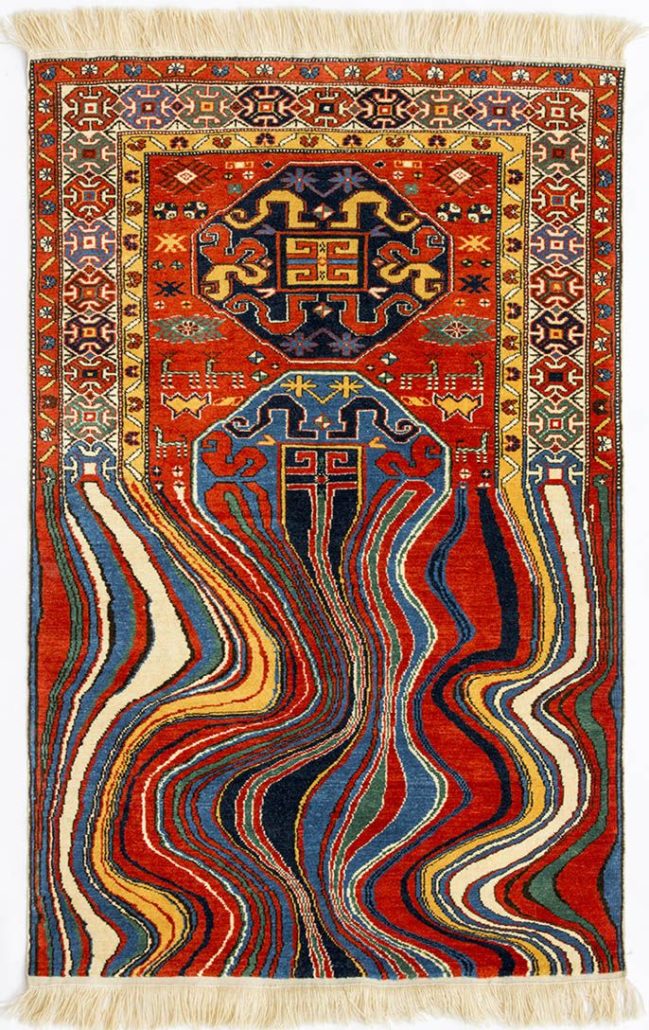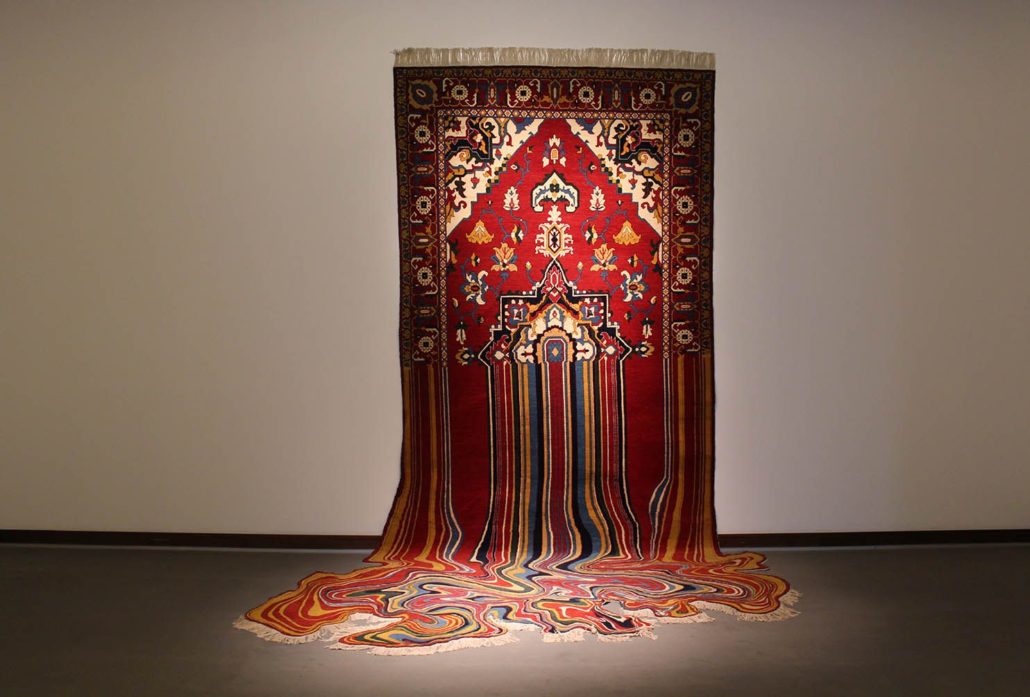Notre rubrique présentant les artistes de la Nouvelle Danse, explore différents arts, différentes cultures et origines. L’universalité des œuvres et des pratiques nous fait voyager à travers le monde et découvrir une mouvance artistique, bien ancrée dans notre époque. La Nouvelle Danse c’est un langage artistique commun, s’inspirant d’hier, d’aujourd’hui et de demain. Les artistes sont nés pour la plupart entre 1980 et l’an 2000.
FAIG AHMED (1982)
Entre tradition et vision
Faig Ahmed nous transporte au cœur de la culture persane de son pays; l’Azerbaïdjan où le tissage traditionnel du tapis est inscrit sur la liste représentative du patrimoine culturel immatériel de l’humanité depuis 2010 (UNESCO).
Connu internationalement, il a notamment représenté son pays lors de la Biennale de Venise en 2007. Faig Ahmed c’est la rencontre entre l’art traditionnel du tapis azerbaïdjanais et des motifs contemporains avant gardistes.
A travers divers projets, le jeune artiste revisite la tapisserie, offrant une nouvelle liberté à cet art ancestral dont la plus vielle pièce connue date du Ve siècle av-JC. Ses œuvres sortent de leurs formes traditionnelles et s’approprient la sculpture ou encore la peinture. Les tapis de Faig Ahmed brouillent les pistes et nous font nous poser la question de la nature même de l’objet. Est-ce vraiment de la tapisserie ? Bluffant.
Son travail sur les distorsions nous renvoient à la notion de perception de la réalité et évoquent des mondes glissants où la rigueur de la forme géométrique laissent place à la liberté et la poésie de la courbe.
La Matière, ici les fibres de laine ou de soie, est belle et bien chez Ahmed, au cœur du sujet, signature des Nouveaux Danseurs, explorant les limites de leur médiums. L’artiste s’ancre dans la mouvance Nouvelle Danse non seulement par l’approche visuelle et philosophique de son travail mais aussi par la fusion de différentes pratiques, en l’occurrence la tapisserie et la sculpture, l’art numérique ou encore l’idée d’une peinture fluide. Sa série Liquid renvoie à l’aspect fluide des peintures de certains créateurs de la Nouvelle Danse et nous rappelle que les artistes à l’origine des motifs des tapis d’époques étaient avant tout peintres.
Ahmed explore également, à travers divers projets toujours plus spectaculaires, des notions de topographie ou encore de surface d’objects, sujets communs aux artistes de la Nouvelle Danse. Créant du lien entre Tradition, Nature et Temporalité Faig Ahmed joue entre les dimensions et s’amuse des notions spatiotemporelles, donnant aux tapis une aura métaphysique et universelle.
Elsa Duault



ENGLISH VERSION
Our section presenting artists of the New Dance, explores different arts, different cultures and origins. The universality of works and practices makes us travel around the world and discover an artistic movement, well anchored in our time. La Nouvelle Danse is a common artistic language, inspired by yesterday, today and tomorrow. The artists were mostly born between 1980 and the year 2000.
FAIG AHMED (1982)
Between tradition and vision
Faig Ahmed transports us to the heart of the Persian culture of his country; Azerbaijan. There traditional carpet weaving has been registered on the representative list of the intangible cultural heritage of humanity since 2010 (UNESCO).
Known internationally, he represented his country at the Venice Biennale in 2007. Faig Ahmed is the encounter between the traditional art of Azerbaijani carpet and avant-garde contemporary patterns.
Through various projects the young artist reinvents tapestry and offers new path to this ancestral art. Besides the oldest known tapestry piece to date is from the 5th century BC. Faig Ahmed’s works are going beyond their traditional forms by exploring sculptural or painting forms and aspects. His rugs blur the lines and make us wonder about the very nature of the object. Is it really tapestry? Bluffing.
His distortions brings us back to the notion of perception of reality by evoking slippery worlds where the rigor of the geometric form gives way to the freedom and poetry of the curve.
The Material, here wool or silk fibers, is in Ahmed’s work at the heart of the subject. Exploring the limits of the materials is one of the New Dancer’s signature. The artist is anchored in the Nouvelle Danse movement not only by the visual and philosophical approach of his work but also by the fusion of different practices, in his case tapestry and sculpture but also digital art or even the idea of a fluid painting. His Liquid series refers to the fluid aspect of paintings made by some of the New Dancer artists. Furthermore it reminds us that, back in time, the artists behind rugs’ patterns were painters.
Ahmed also explores through various spectacular projects some notions of topography and surface of objects, common topics for the artists of the New Dance. By creating links between Tradition, Nature and Temporality Faig Ahmed plays with dimensions and spatio-temporal notions, giving the rugs a metaphysical and universal aura.
Elsa Duault


